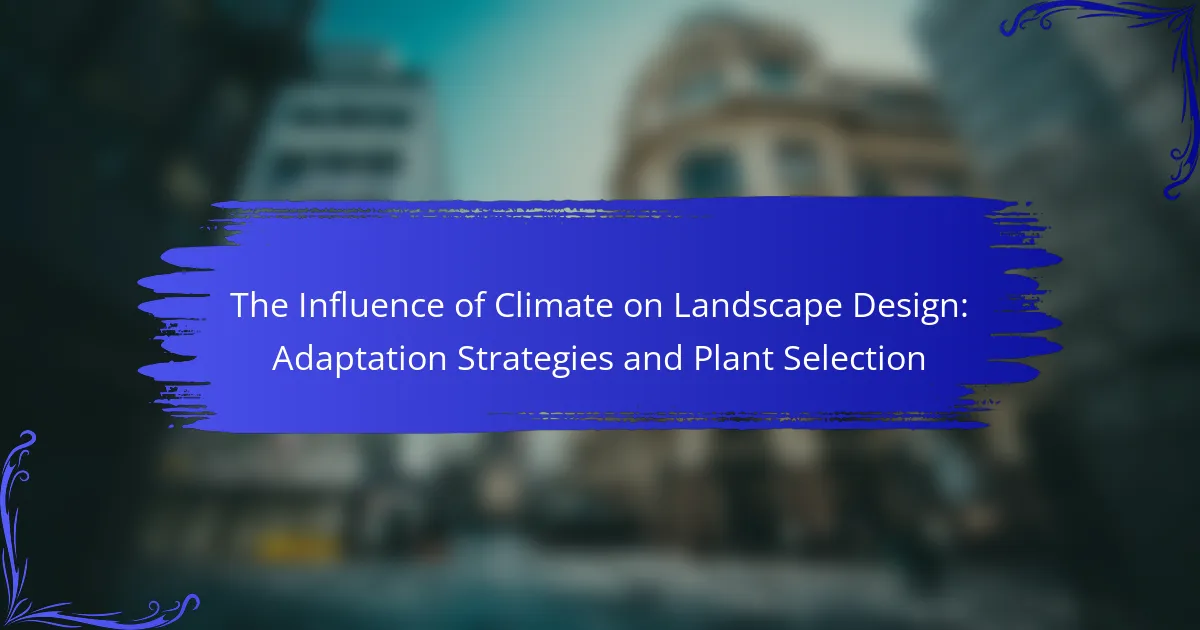Climate plays a crucial role in landscape design, influencing plant selection, irrigation practices, and the choice of materials. Different climates necessitate specific plants that can thrive in local conditions, such as drought-resistant varieties for arid regions and a diverse range of vegetation for humid areas. Effective adaptation strategies include selecting climate-resilient plants, implementing water-efficient irrigation systems, and designing for biodiversity to enhance ecosystem stability. Research highlights that these climate-adaptive landscapes can significantly reduce water usage and improve resilience to climate change by utilizing native species and promoting genetic diversity among plants. Understanding microclimates further aids in optimizing plant selection for enhanced growth and sustainability.

What is the influence of climate on landscape design?
Climate significantly influences landscape design by dictating plant selection, irrigation needs, and overall design strategies. Different climates require specific plants that can thrive in local conditions. For example, arid climates favor drought-resistant plants, while humid climates support a wider variety of vegetation. Additionally, climate impacts the types of materials used in landscaping. For instance, heat-resistant materials may be prioritized in warmer areas. Seasonal changes also affect maintenance practices and plant care. Understanding climate patterns helps landscape designers create sustainable and resilient environments. Research shows that climate-adaptive landscapes can reduce water usage by up to 50%.
How does climate affect landscape aesthetics and functionality?
Climate significantly influences landscape aesthetics and functionality. Different climates affect plant selection and growth patterns. For example, arid climates require drought-resistant plants, impacting visual appeal. Conversely, humid climates support lush vegetation, enhancing aesthetic value. Climate also dictates seasonal changes in landscapes. These changes can alter color palettes and textures throughout the year. Furthermore, climate affects soil health and water availability. Healthy soil promotes diverse plant life, improving both beauty and ecosystem function. Research shows that climate variations lead to shifts in landscape design strategies. Adaptation is crucial for maintaining both aesthetics and functionality in changing climates.
What are the key climate factors impacting landscape design?
Key climate factors impacting landscape design include temperature, precipitation, humidity, and wind patterns. Temperature influences plant selection and growth cycles. Precipitation affects soil moisture levels and irrigation needs. Humidity impacts plant health and pest prevalence. Wind patterns can influence plant placement and structural design. These factors dictate the suitability of specific plants and materials. Understanding these elements is essential for creating resilient landscapes. For instance, regions with high temperatures require drought-tolerant species. Similarly, areas with high humidity may need plants resistant to fungal diseases.
How do varying climates lead to different landscape design approaches?
Varying climates significantly influence landscape design approaches. Different climates require unique strategies for plant selection and layout. For instance, arid climates necessitate drought-resistant plants and xeriscaping techniques. In contrast, tropical climates favor lush vegetation and water features to manage rainfall. Cold climates often incorporate insulation techniques and hardy plants to withstand frost. Each climate’s temperature, precipitation, and seasonal variations dictate suitable materials and designs. Research shows that climate-adaptive landscaping can enhance biodiversity and resilience. The USDA Plant Hardiness Zone Map illustrates how climate zones affect plant survival, guiding landscape design choices.
Why is understanding climate vital for landscape architects?
Understanding climate is vital for landscape architects because it directly impacts design choices and plant selection. Climate influences temperature, precipitation, and sunlight, which dictate what plants can thrive in a specific area. For instance, a landscape architect must consider local climate zones to choose appropriate vegetation. This ensures sustainable growth and minimizes maintenance needs. Furthermore, climate understanding aids in managing water resources effectively. It helps in implementing strategies for erosion control and stormwater management. According to the American Society of Landscape Architects, climate considerations are essential for creating resilient landscapes. Resilient landscapes can adapt to changing climatic conditions, ensuring longevity and ecological balance.
How does climate knowledge enhance design sustainability?
Climate knowledge enhances design sustainability by informing the selection of materials and plants suited to local conditions. This knowledge helps in predicting environmental impacts, such as heat, rainfall, and wind patterns. Understanding these factors allows designers to create resilient landscapes that require less maintenance and resources. For example, using drought-resistant plants reduces water consumption. Additionally, climate knowledge aids in planning for future climate scenarios, ensuring long-term viability. Research indicates that designs informed by climate data can lower energy costs by optimizing natural heating and cooling. Thus, climate awareness directly contributes to more sustainable design practices.
What risks are associated with neglecting climate in landscape design?
Neglecting climate in landscape design can lead to several significant risks. These risks include plant failure due to inappropriate species selection. Plants not suited for the local climate may struggle to survive, resulting in increased maintenance costs. Additionally, improper water management can occur, leading to either drought stress or waterlogging. This can further compromise plant health and soil quality.
Moreover, neglecting climate can increase vulnerability to pests and diseases. Certain pests thrive in specific climate conditions, and unsuitable plant choices may attract them. Furthermore, landscapes may become less resilient to extreme weather events. For example, heavy rainfall can cause erosion in poorly designed landscapes.
Ultimately, these risks can diminish the ecological value of landscapes. They may also negatively impact aesthetic appeal and property value. Therefore, considering climate is essential for sustainable and effective landscape design.

What adaptation strategies can be employed in landscape design?
Adaptation strategies in landscape design include selecting climate-resilient plants, implementing water-efficient irrigation systems, and designing for biodiversity. Climate-resilient plants are chosen for their ability to withstand local climate conditions. Water-efficient irrigation systems, like drip irrigation, reduce water waste and optimize usage. Designing for biodiversity enhances ecosystem stability and resilience. These strategies help landscapes adapt to changing climatic conditions and promote sustainability.
How can landscape designs be adapted to changing climates?
Landscape designs can be adapted to changing climates by incorporating drought-resistant plants and using native species. Drought-resistant plants require less water and thrive in arid conditions. Native species are better suited to local climates and require less maintenance. Additionally, landscape designs can include rain gardens to manage stormwater and reduce runoff. Implementing permeable paving helps with water absorption and reduces flooding. Using mulch can retain soil moisture and regulate temperature. Finally, planning for shade through tree placement can mitigate heat effects in urban areas. These strategies enhance resilience against climate variability.
What are the best practices for climate-resilient landscape design?
Best practices for climate-resilient landscape design include selecting native plants, using sustainable materials, and implementing water-efficient practices. Native plants are adapted to local climates and require less maintenance. Sustainable materials reduce the environmental impact of construction. Water-efficient practices, such as rain gardens and xeriscaping, help manage stormwater and conserve water resources. Incorporating diverse plant species enhances ecosystem resilience. Designing for shade and wind protection can mitigate temperature extremes. These strategies collectively support biodiversity and reduce vulnerability to climate change impacts.
How do local climate conditions influence adaptation strategies?
Local climate conditions significantly influence adaptation strategies in landscape design. These conditions determine plant selection, irrigation methods, and soil management practices. For example, arid climates require drought-resistant plants and efficient water use strategies. Conversely, humid climates may focus on plants that thrive in moisture-rich environments. Temperature variations also dictate seasonal planting schedules and crop choices. Research indicates that regions experiencing extreme weather events must adapt by incorporating resilient species and sustainable practices. This adaptation ensures ecological balance and long-term viability of landscapes.
Why is plant selection crucial in climate adaptation?
Plant selection is crucial in climate adaptation because it directly influences ecosystem resilience. Choosing the right plants ensures that landscapes can withstand changing climate conditions. Specific plants may thrive in altered temperatures and precipitation patterns. For instance, drought-resistant species are essential in arid regions experiencing reduced rainfall. Additionally, native plants often require less maintenance and support local wildlife. Research shows that well-selected plant communities can reduce soil erosion and improve water retention. This selection process ultimately leads to sustainable landscapes that can adapt over time.
What criteria should be considered for selecting plants in various climates?
Criteria for selecting plants in various climates include climate zone, temperature tolerance, and moisture requirements. Climate zones categorize regions based on temperature and precipitation patterns. Temperature tolerance indicates how well a plant can survive in extreme heat or cold. Moisture requirements define how much water a plant needs to thrive. Additionally, soil type and drainage capabilities are crucial for plant health. Native species often adapt better to local conditions. Understanding these factors helps ensure successful plant growth in diverse environments.
How do native plants contribute to climate adaptation in landscapes?
Native plants enhance climate adaptation in landscapes by improving resilience and biodiversity. They are well-suited to local climates and soil conditions. This adaptability reduces the need for irrigation and chemical fertilizers. Native plants also support local wildlife, promoting ecological balance. Research shows that landscapes with native plants can withstand extreme weather events better. For instance, native plants can mitigate soil erosion during heavy rains. They also help regulate temperatures in urban areas, reducing the urban heat island effect. Studies indicate that integrating native plants in landscape design leads to more sustainable ecosystems.

What specific plant selection strategies are effective for climate adaptation?
Effective plant selection strategies for climate adaptation include choosing native species, selecting drought-resistant varieties, and incorporating genetic diversity. Native species are well-adapted to local conditions and support local ecosystems. Drought-resistant varieties can survive low water availability, which is crucial in changing climates. Incorporating genetic diversity enhances resilience to pests and diseases.
Research indicates that using a mix of species can improve ecosystem stability. For example, a study by the National Academy of Sciences found that diverse plant communities are more resilient to climate stressors. Additionally, understanding microclimates within a landscape can guide plant selection for optimal growth conditions. These strategies collectively enhance the ability of landscapes to adapt to climate change.
How can plant diversity enhance landscape resilience?
Plant diversity enhances landscape resilience by increasing ecosystem stability and adaptability. Diverse plant species can better withstand extreme weather events. This variety promotes a range of root structures, which improves soil health and reduces erosion. Additionally, different plants provide habitats for various wildlife, contributing to a balanced ecosystem. Studies show that landscapes with higher plant diversity recover more quickly after disturbances. For instance, research indicates that diverse ecosystems can recover from droughts up to 50% faster than monocultures. Furthermore, plant diversity can improve water retention in soils, aiding in drought resistance. Overall, a diverse plant community supports a more resilient landscape in the face of climate change.
What types of plants are best suited for arid climates?
Succulent plants are best suited for arid climates. These plants have adapted to conserve water in dry environments. Cacti are a prime example, storing water in their thick stems. Another suitable type is drought-resistant shrubs like sagebrush. These shrubs have deep root systems that access moisture underground. Additionally, native grasses such as buffalo grass thrive in arid conditions. They require minimal water and are resilient to heat. Xerophytes, a category that includes many succulents, are specifically adapted to survive with little water. These plants play a crucial role in sustainable landscaping in arid regions.
Which plants thrive in humid environments and why?
Tropical plants thrive in humid environments due to their adaptation to high moisture levels. These plants, such as ferns, orchids, and bromeliads, have evolved to absorb moisture from the air. They often feature large leaves to maximize water absorption. The high humidity prevents excessive water loss through transpiration. Additionally, many tropical plants have specialized structures, like aerial roots, to capture moisture. This adaptation allows them to thrive in rainforests, where humidity levels can exceed 80%. Their growth is supported by the consistent availability of water and nutrients in these environments.
What are the challenges in selecting plants for climate adaptation?
Selecting plants for climate adaptation presents several challenges. One major challenge is identifying species that can thrive in changing environmental conditions. Climate variability affects temperature, precipitation patterns, and soil moisture levels. These changes can stress plant species that are not resilient. Additionally, the availability of native plants may be limited due to habitat loss. This restricts options for selection. Another challenge is predicting future climate scenarios. Uncertainty in climate models complicates the selection process. Furthermore, invasive species may outcompete native plants, disrupting ecosystems. Lastly, understanding the interactions between plants and local wildlife is crucial. These interactions can influence plant survival and adaptation.
How can invasive species impact plant selection in landscape design?
Invasive species can significantly impact plant selection in landscape design by outcompeting native plants. This competition can lead to reduced biodiversity in the landscape. Native plants often provide essential ecosystem services, such as habitat for wildlife. When invasive species dominate, these services may be diminished.
Invasive species can also alter soil chemistry and structure. This change can make it difficult for native plants to thrive. For example, some invasive plants may release allelopathic chemicals that inhibit the growth of nearby plants.
Furthermore, invasive species can increase maintenance costs for landscape designers. They often require more resources to manage and control. This can lead to higher long-term expenses for landscape projects.
Overall, the presence of invasive species necessitates careful consideration in plant selection for landscape design to maintain ecological balance and sustainability.
What role does soil quality play in plant selection for climate resilience?
Soil quality significantly impacts plant selection for climate resilience. Healthy soil provides essential nutrients and supports root development. It influences water retention, which is crucial during drought conditions. Soil texture and structure affect drainage and aeration, impacting plant health. High organic matter content enhances soil fertility and microbial activity. Specific plants thrive in different soil types, making soil compatibility vital for survival. Research indicates that plants suited to local soil conditions are more resilient to climate stressors. For instance, native plants often adapt better to local soil variations, improving ecosystem stability.
What practical tips can landscape designers use for effective plant selection?
Landscape designers can enhance plant selection by considering climate adaptability. Choosing plants suited to local climate conditions ensures better growth and sustainability. For instance, native plants typically require less water and maintenance. Understanding soil types and drainage is crucial for plant health. Designers should also assess sunlight exposure in different areas. Grouping plants with similar water and light needs promotes efficient care. Seasonal interest through diverse plant selection enhances aesthetic appeal throughout the year. Utilizing local resources, such as extension services, can provide valuable insights on suitable species. These strategies lead to healthier landscapes and reduced resource consumption.
The main entity of the article is climate and its influence on landscape design. The article examines how climate affects plant selection, irrigation needs, and design strategies, highlighting the importance of understanding local climate conditions for sustainable and resilient landscapes. Key climate factors such as temperature, precipitation, humidity, and wind patterns are discussed, along with adaptation strategies that include selecting climate-resilient plants and implementing water-efficient practices. Additionally, the article emphasizes the role of native plants in enhancing ecosystem stability and the challenges posed by invasive species in plant selection for climate adaptation.
